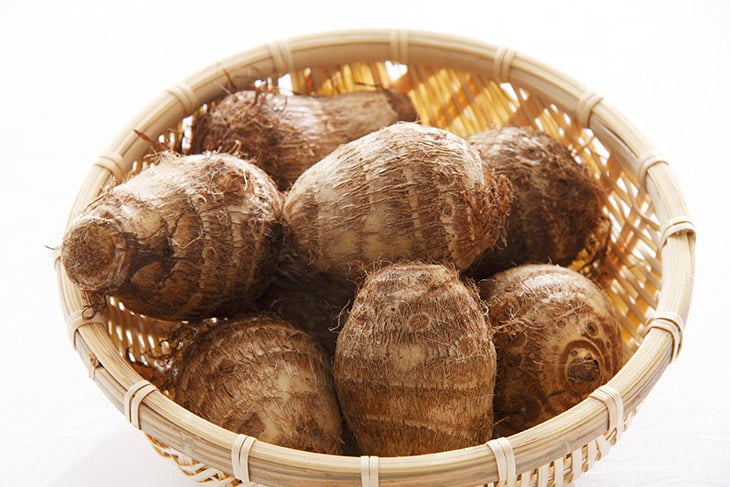How To Grow Taro

How to grow taro
And a lot of leaves but hardly any roots that's why you should always grow taro in the ground taro
Does taro plant multiply?
Initial multiplication of taro was achieved by dividing corms into pieces, each with several buds, and planting them in sterile potting mix. Surface planting and decapitation of the new primary meristem on each sucker forced additional shoot meristems to grow.
Can I plant taro root from the grocery store?
Verdict: Yes, you can grow Taro from the grocery store. Even if you don't come from a long line of farmers.
Can I grow taro at home?
The tubers will germinate within a few days and a small leaf will emerge from the ground taro needs
Is taro toxic when raw?
The leaves of the taro plant contain high levels of oxalates that can be poisonous when consumed raw. It's important to properly cook them to avoid harmful side effects.
Why can you not eat taro raw?
Taro root should never be consumed raw. The vegetable contains a bitter-tasting compound called calcium oxalate. This can cause an itchy mouth and throat if consumed raw but is safe to eat when cooked. Choose a taro root based on what you want to use it for.
Can taro be grown in pots?
Taro is a water plant, but you don't need a pond or wetlands in your backyard to grow it. You can successfully grow taro in containers if you do it right. You can grow this pretty tropical plant as an ornamental or harvest the roots and leaves to use in the kitchen. Either way they make great container plants.
Can taro survive winter?
This plant is ideal for those hard-to-fill spaces in your garden that flood frequently. During the winter, however, keep the tubers dry so the plant can go dormant. High humidity is best for this plant. Indoors, use a plant humidifier to keep the taro leaves happy.
Is taro annual or perennial?
Although cultivated as an annual, taro is a perennial herb with a thick, tuberous underground stem whose leaves are simple, broad, and long-petioled.
How many days does taro root take to grow?
The whole process takes about 200 days from planting corms to harvest. To harvest the corms (tubers), lift them gently from the soil with a garden fork just before the first frost in the fall. The leaves may be picked as soon as the first few leaves have opened.
Where does taro grow best?
Taro is a tropical or subtropical plant that requires very warm temperatures–77° to 95°F (25-35°C)–and consistent moisture to thrive. Taro grows best in USDA zones 9-11. Taro can be grown for its tubers only where summers are long–at least 200 frost-free, warm days.
Can you eat taro leaves?
Taro leaves are heart-shaped leaves of the taro plant (Colocasia esculenta), commonly grown in subtropical and tropical regions. Although the taro plant is best known for its starchy roots that can be used as food, the leaves of this plant are also used as a staple food in many different cuisines.
How often should I water my taro plant?
During the growing season, chinese taro requires great amounts of water due to its large leaves. Watering outdoor plants depends on the weather. Generally, potted plants should be sprayed with water once a day and watered when the surface layer of the soil is slightly dry.
Can you touch raw taro?
Just a little FYI: Taro, in its raw form, is poisonous. Once cooked, it's totally safe to eat, but even touching taro can cause severe skin irritation so it's important to handle this vegetable carefully.
Is taro and elephant ear plant the same?
Wild taro is commonly confused with elephant ear (Xanthosoma sagittifolium). Both elephant ear and taro are herbaceous perennials with large leaves up to 6 feet in length. Taro can be distinguished from elephant ears by the attachment of the leaf from the petiole.
Which taro is not edible?
Sadly, black taro and elephant ears are no good for eating. While classified Colocasia esculenta, the same species as the edible variety, these ornamental plants do not produce the large underground corms that are eaten as a staple food in tropical countries all over the world.
Why does my throat hurt after eating taro leaves?
This is caused due to the presence of calcium oxalate in the plant. To prevent the annoying itch, people apply generous amounts of mustard oil on hands before cutting the vegetable. This is fried on high heat in a little extra oil to eliminate chances of itchy throat or mouth when consumed.
Is taro healthier than potato?
Taro root contains more than 6 grams of fiber per cup (132 grams) — more than twice the amount found in a comparable 138-gram serving of potatoes — making it an excellent source of fiber (1, 11).
How poisonous is taro?
Symptoms: If any part of this plant is chewed or eaten raw, it can cause immediate burning pain and swelling of the lips, mouth and tongue. Swelling may cause copious salivation and difficulty in breathing, swallowing or speaking. Intense gastric irritation may occur if swallowed.
Who should not eat taro root?
03/6Taro root or arbi It is prepared dry as well as with curry. The vegetable is tasty and goes well with dal but people suffering from gastric issues should not consume it, as it can cause bloatedness.












Post a Comment for "How To Grow Taro "